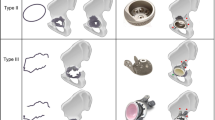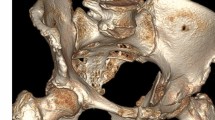Abstract
Objective
The aim was to develop a CT-based protocol to accurately measure post-operative acetabular cup inclination and anteversion establishing which bony reference points facilitate the most accurate estimation of these variables.
Materials and methods
An all-polyethylene acetabular liner was implanted into a cadaveric acetabulum. A conventional pelvic CT scan was performed and reformatted images created in both functional and anterior pelvic planes. CT images were transferred to a Freedom-Plus Graphics software package enabling an identical, virtual 3D model of the cadaveric pelvis to be created and definitive acetabular cup orientation established. Using coronal and axial slices of the CT scans, acetabular cup inclination and anteversion were measured on five occasions by ten radiographers using differing predetermined bony landmarks as reference points. The intra- and inter-observer variation in measurement of acetabular cup orientation using varying bony reference points was assessed in comparison to the elucidated definitive cup position.
Results and conclusion
Virtually derived definitive acetabular cup orientation was measured showing cup inclination and anteversion as 41.0 and 22.5° respectively. Mean CT-based measurement of cup inclination and anteversion by ten radiographers were 43.1 and 20.8° respectively. No statistically significant difference was found in intra- and inter-observer recorded results. No statistically significant differences were found when using different bony landmarks. CT assessment of acetabular component inclination and anteversion is accurate, reliable and reproducible when measured using differing bony landmarks as reference points. We recommend measuring acetabular inclination and anteversion from the inferior acetabular wall/teardrop and posterior ischium respectively.












Similar content being viewed by others
References
Ali Khan MA, Brakenbury PH, Reynolds IS. Dislocation following total hip replacement. J Bone Joint Surg (Br). 1981;63-B:214–8.
Lewinnek GE, Lewis JL, Tarr R, Compere LC, Zimmerman J. Dislocations after total hip replacement arthroplasties. J Bone Jt Surg Am. 1978;217–20.
Steppacher SD, Tannast M, Zheng G, Zhang X, Kowal J, Anderson SE, et al. Validation of a new method for determination of cup orientation in THA. J Orthop Res. 2009;27:1583–8.
Grutzner PA, Zheng G, Langlotz U, von Recum J, Nolte LP, Wentzensen A, et al. C-arm based navigation in total hip arthroplasty-background and clinical experience. Injury. 2004;35 Suppl 1:S – A90–5.
Kalteis T, Handel M, Herold T, Perlick L, Paetzel C, Grifka J. Position of the acetabular cup—accuracy of radiographic calculation compared to CT-based measurement. Eur J Radiol. 2006;58:294–300.
Saxler G, Marx A, Vandevelde D, Langlotz U, Tannast M, Wiese M, et al. The accuracy of free-hand cup positioning—A CT based measurement of cup placement in 105 total hip arthroplasties. Int Orthop. 2004;28:198–201.
Kalteis T, Beckmann J, Herold T, Zysk S, Bathis H, Perlick L, et al. Accuracy of an image-free cup navigation system—an anatomical study. Biomed Tech. 2004;49:257–62.
Murray DW. The definition and measurement of acetabular orientation. J Bone Joint Surg (Br). 1993;75:228–32.
Ackland MK, Bourne WB, Uhthoff HK. Anteversion of the acetabular cup—measurement of angle after total hip replacement. J Bone Jt Surg Br. 1986;68:409–13.
Mian SW, Truchly G, Pflum FA. Computed tomography measurement of acetabular cup anteversion and retroversion in total hip arthroplasty. Clin Orthop Relat Res. 1992;206–9.
Olivecrona H, Weidenhielm L, Olivecrona L, Beckman MO, Stark A, Noz ME, et al. A new CT method for measuring cup orientation after total hip arthroplasty: a study of 10 patients. Acta Orthop Scand. 2004;75:252–60.
Wines AP, McNicol D. Computed tomography measurement of the accuracy of component version in total hip arthroplasty. J Arthroplasty. 2006;21:696–701.
Olivecrona L, Olivecrona H, Weidenhielm L, Noz ME, Maguire GQ, Zeleznik MP. Model studies on acetabular component migration in total hip arthroplasty using CT and a semiautomated program for volume merging. Acta Radiol. 2003;44:419–29.
Olivecrona H, Weidenhielm L, Olivecrona L, Noz ME, Maguire GQ, Zeleznik MP, et al. Spatial component position in total hip arthroplasty: accuracy and repeatability with a new CT method. Acta Radiol. 2003;44:84–91.
Olivecrona H, Olivecrona L, Weidenhielm L, Noz ME, Maguire GQ, Zeleznik MP, et al. Stability of acetabular axis after total hip arthroplasty, repeatability using CT and a semiautomated program for volume fusion. Acta Radiol. 2003;44:653–61.
Lin F, Lim D, Wixson RL, Milos S, Hendrix RW, Makhsous M. Validation of a computer navigation system and a CT method for determination of the orientation of implanted acetabular cup in total hip arthroplasty: a cadaver study. Clin Biomech. 2008;23:1004–11.
Herrlin K, Pettersson H, Selvik G. Comparison of two- and three-dimensional methods for assessment of orientation of the total hip prosthesis. Acta Radiol. 1988;29:357–61.
Pettersson H, Gentz CF, Lindberg HO, Carlsson AS. Radiologic evaluation of the position of the acetabular component of the total hip prosthesis. Acta Radiol Diagn (Stockh). 1982;23:259–63.
Widmer K-H. A simplified method to determine acetabular cup anteversion from plain radiographs. J Arthroplasty. 2004;19:387–90.
Arai N, Nakamura S, Matsushita T. Difference between 2 measurement methods of version angles of the acetabular component. J Arthroplasty. 2007;22:715–20.
Fontes D, Benoit J, Lortat-Jacob A, Didry R. Luxation of total hip prosthesis. Mathematic modelization and biomechanical approach. Rev Chir Orthop Reparatrice Appar Mot. 1991;77:151–62.
Hassan DM, Johnston GHF, Dust WNC, Watson G, Cassidy D. Radiographic calculation of anteversion in acetabular prostheses. J Arthroplasty. 1995;10:369–72.
Paterno SA, Lachiewicz PF, Kelley SS. The influence of patient-related factors and the position of the acetabular component on the rate of dislocation after total hip replacement. J Bone Joint Surg Am. 1997;79:1202–10.
Tannast M, Zheng G, Anderegg C, Burckhardt K, Langlotz F, Ganz R, et al. Tilt and rotation correction of acetabular version on pelvic radiographs. Clin Orthop Relat Res. 2005;438:182–90.
Seradge H, Nagle KR, Miller RJ. Analysis of version in the acetabular cup. Clin Orthop Relat Res. 1982;152–7.
Visser JD, Konings JG. A new method for measuring angles after total hip arthroplasty. A study of the acetabular cup and femoral component. J Bone Joint Surg (Br). 1981;63B:556–9.
Yao L, Yao J, Gold RH. Measurement of acetabular version on the axiolateral radiograph. Clin Orthop Relat Res. 1995;106–11.
Ghelman B, Kepler CK, Lyman S, Della Valle AG. CT outperforms radiography for determination of acetabular cup version after THA. Clin Orthop Relat Res. 2009;467:2362–70.
Ybinger T, Kumpan W, Hoffart HE, Muschalik B, Bullmann W, Zweymüller K. Accuracy of navigation-assisted acetabular component positioning studied by computed tomography measurements. J Arthroplasty. 2007;22:812–7.
Hernandez RJ, Tachdjian MO, Poznansk AK, Dias LS. CT determination of femoral torsion. Am J Roentgenol. 1981;137:97–101.
Arai N, Nakamura S, Matsushita T, Suzuki S. Minimal radiation dose computed tomography for measurement of cup orientation in total hip arthroplasty. J Arthroplasty. 2010;25:263–7.
Author information
Authors and Affiliations
Corresponding author
Ethics declarations
Conflict of interest
The authors declare that they have no conflict of interest.
Rights and permissions
About this article
Cite this article
Arora, V., Hannan, R., Beaver, R. et al. A cadaver study validating CT assessment of acetabular component orientation: the Perth CT hip protocol. Skeletal Radiol 46, 177–183 (2017). https://doi.org/10.1007/s00256-016-2527-z
Received:
Accepted:
Published:
Issue Date:
DOI: https://doi.org/10.1007/s00256-016-2527-z




